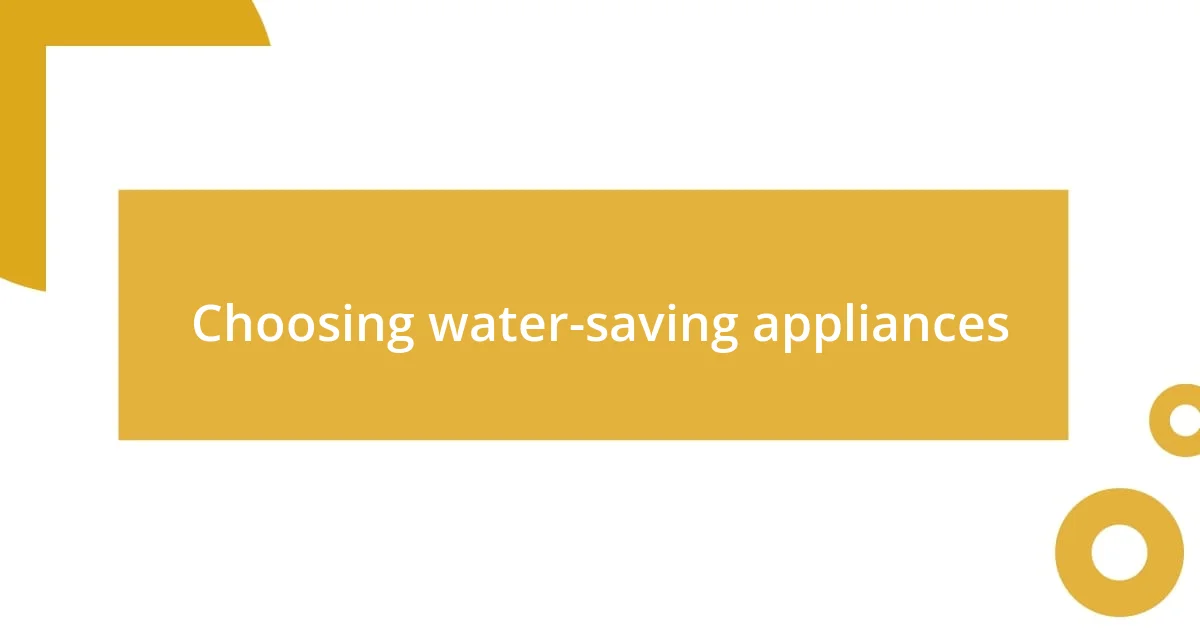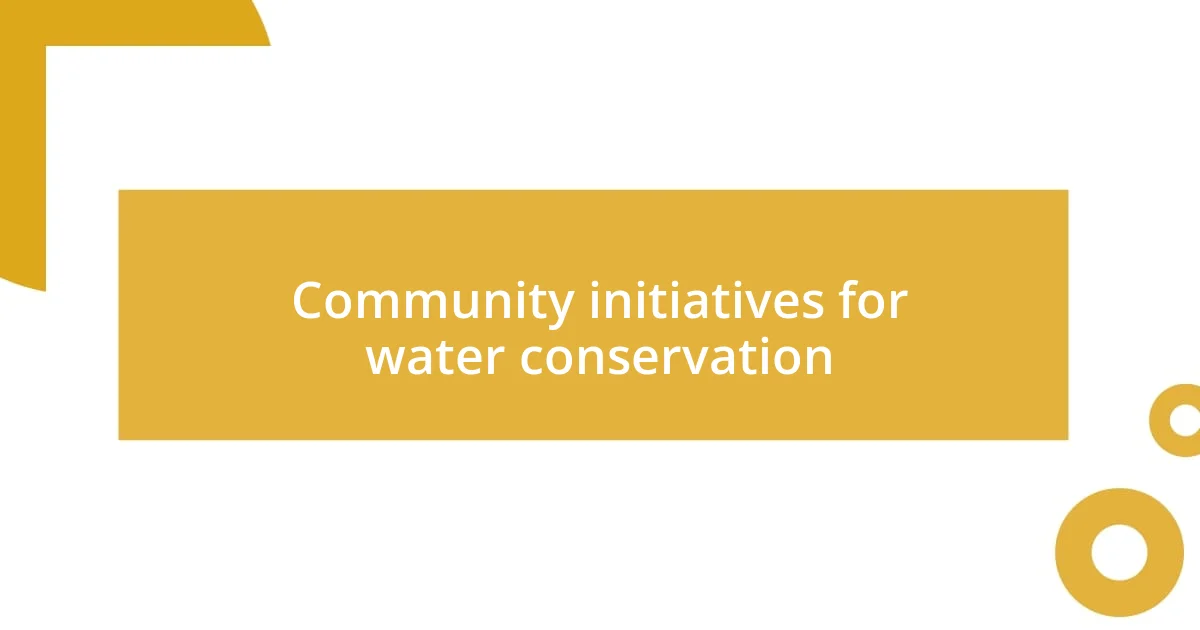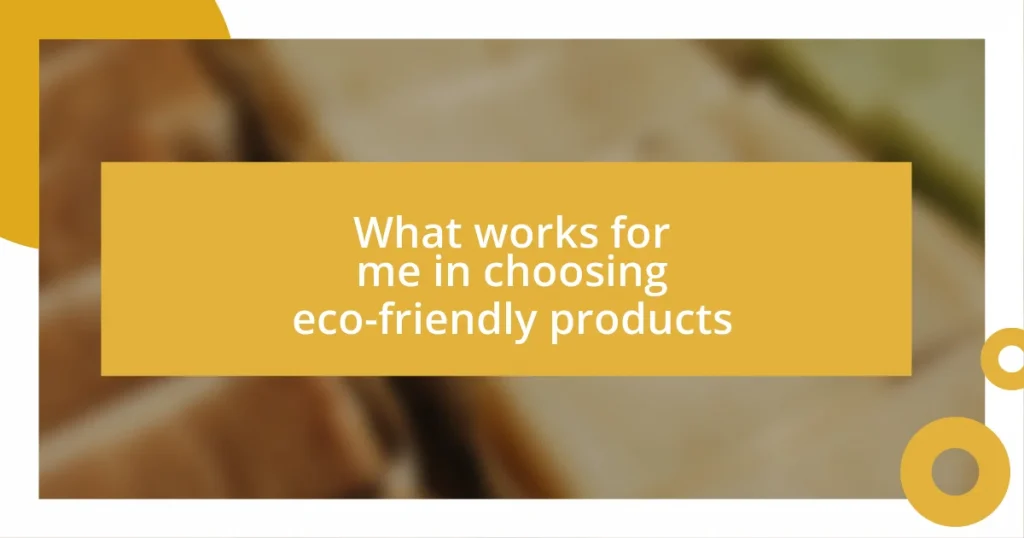Key takeaways:
- Implementing small daily habits, such as using a pitcher for drinking water and switching to low-flow appliances, can significantly reduce water consumption.
- Smart landscaping techniques, like using drought-resistant plants and drip irrigation, enhance garden aesthetics while conserving water.
- Engaging in community initiatives, such as cleanup events and rainwater harvesting workshops, can cultivate collective efforts for water conservation and raise awareness.

Understanding water conservation benefits
Water conservation isn’t just about saving the environment; it’s also about saving money. I remember the first time I saw my water bill drop significantly after I began taking shorter showers. It felt like finding extra cash in my pocket—small changes can have a big impact!
Have you ever thought about how much water is wasted while waiting for it to heat up? I used to let the tap run, feeling guilty the whole time, until I realized I could fill a bucket to reuse that cold water for my plants. This small shift turned what felt like a wasteful moment into a sustainable act, all while nurturing new blooms in my garden.
Moreover, conserving water helps protect local wildlife and ecosystems. One summer, I volunteered at a wetland restoration project, and seeing firsthand how crucial water management is for these habitats made an impression on me. It’s powerful to think that every drop we save contributes to preserving the delicate balance of nature and ensuring that our planet thrives for generations to come.

Daily habits for saving water
When it comes to my daily routine, I’ve found that small changes make a world of difference in conserving water. For instance, I always keep a pitcher in the refrigerator for drinking water instead of letting the tap run until it’s cold. This not only saves water but also ensures I have refreshing water on hand at all times. Have you ever noticed how long it takes to fill a glass from a running tap?
I also switched to using a broom instead of a hose to clean the driveway. It might sound trivial, but the feeling of accomplishment I get from doing my part and seeing the clean surface without wasting gallons of water is rewarding. Plus, it gives me a chance to take a break and enjoy the outdoors—focus on my surroundings rather than just cleaning!
Finally, planning meals has changed my water usage significantly. I try to prepare more meals that involve soaking beans or grains rather than cooking everything from scratch. This not only enhances flavor but helps me appreciate water’s importance in cooking. Do you ever consider the water footprint of what you cook? It’s a great conversation starter and makes for more mindful eating.
| Habit | Water Saved |
|---|---|
| Using a pitcher for drinking water instead of running tap | 2-3 gallons daily |
| Using a broom instead of a hose for cleaning | 50 gallons per cleaning |
| Cooking methods that involve soaking | Varies, but can save 10-15 gallons per meal |

Smart landscaping for water efficiency
Smart landscaping for water efficiency
When I decided to revamp my garden, I immediately considered water efficiency. I shifted to drought-resistant plants, and I can’t tell you how liberating it feels to have a vibrant garden that thrives on minimal water. Watching the bees buzz around my native flowers, knowing I’m lowering my water use, gives me such joy and a sense of purpose.
I also implemented techniques like mulching and drip irrigation, which have made a remarkable difference. Here’s why these methods stand out:
- Drought-resistant plants: They require less water while still providing beauty and habitat for wildlife.
- Mulching: This not only retains soil moisture but reduces weed growth too, which means less manual work for me!
- Drip irrigation: It delivers water directly to plant roots, reducing evaporation and runoff.
- Rain gardens: These absorb excess rainwater, filtering it naturally and minimizing runoff into storm drains.
I remember the thrill of seeing my water bill decrease even while my garden flourished. It’s incredible how being mindful about landscaping not only conserves water but also enhances my outdoor space. What a win-win situation!

Choosing water-saving appliances
Choosing water-saving appliances has transformed the way I interact with my home. When I recently upgraded to a high-efficiency washing machine, I was amazed at how it uses about 40% less water than my old model. I used to dread laundry day, but now I actually look forward to it, knowing I’m doing my part for the environment. Have you ever considered the impact your appliances have on water conservation?
Another change I made was switching to low-flow showerheads. I used to take long, relaxing showers, but I’ve since realized that shorter showers can still be just as refreshing. The first time I installed one, I was surprised at how powerful it felt while saving precious gallons of water. It’s as if I found a new appreciation for my shower routine—every drop counts!
Lastly, I can’t help but mention my new Energy Star dishwasher. It’s incredible how it uses about 3 gallons per load compared to the 10 gallons required by hand washing. Not only has this made my kitchen cleanup much easier, but it’s also sparked conversations during dinner about how even small appliance choices can lead to larger water savings. Have you thought about what appliances you could swap out for more efficient options? It’s empowering to know that each step I take contributes to a greater cause.

Monitoring and managing water usage
Keeping a close eye on my water usage has become a daily ritual for me. I installed a smart water meter that tracks my consumption in real time. It’s fascinating—and somewhat surprising—how seeing those numbers change motivates me to be more mindful. Have you ever noticed how small habits can blossom into bigger changes when you’re aware of your impact?
On days when I feel a little lazy about checking my usage, I often find myself reflecting on the times I wasted water without even realizing it. Recently, I made a point to time my shower, which used to stretch into blissful oblivion. Now, I challenge myself to keep it under five minutes, and honestly, it feels incredible to step out, refreshed but also proud of wasting less. It’s wild how just a little awareness transforms not just my habits, but my mindset as well.
Additionally, I like to have a weekly check-in on my water bill. Each month brings a bit of suspense—did my efforts pay off? When I notice a reduction, it feels like I’m being rewarded for my conscious choices. I often share these insights with friends, sparking discussions about their own water-saving journeys. Have you ever thought of turning those numbers into a motivating challenge? It’s empowering and can lead to a supportive community focused on conserving this precious resource together.

Community initiatives for water conservation

Community initiatives for water conservation
One initiative that left a lasting impression on me was our local community cleanup event centered around our nearby river. Not only did we pull out garbage, but we also learned about the native plants that help maintain the ecosystem. Watching my neighbors come together to protect our precious water source made me realize how individual efforts can culminate into a powerful force for conservation. Isn’t it amazing how grassroots efforts can foster community spirit while addressing vital environmental issues?
Another memorable experience was when I joined a workshop organized by the city on rainwater harvesting. It’s a simple yet effective method to collect water for gardening and non-potable uses. Getting hands-on experience, coupled with experts sharing their knowledge, gave me useful insights to try at home. Have you ever thought about how capturing rainwater could not only save water but also educate others in your community?
There’s also a monthly water conservation challenge that my neighborhood participates in. Each family sets their own goals—whether it’s reducing usage by a certain percentage or just being more mindful about habits. At the end of the month, we gather to share tips and stories over tea. This sense of camaraderie and accountability encourages me to push my limits. It’s incredible how sharing personal successes and struggles can strengthen our commitment to water conservation. Have you considered organizing something similar in your own community?













